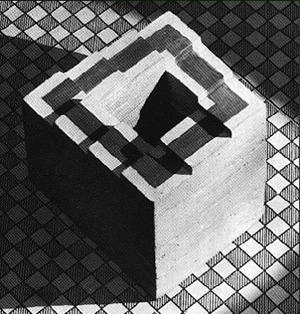| Follow the
staircase around. Can you determine the lowest or highest step?
What happens when you
go around in a clockwise direction?
What happens when you
go around in a counter-clockwise direction?
So what's Happening?
The is a physical model
of an impossible staircase designed by genetist Lionel Penrose. It is the
first impossible object ever made and served as an inspiration for M.
C. Escher's famous print that incorporates this staircase, "Ascending
and Descending."
The actual model is separated
at the right stair, but you can't see the split, because your visual system
assumes that it is seeing this model from a non-accidental point of view;
hence, it assumes that the stairs are joined.
Although the staircase
is conceptually impossible, it does not interfere with your perception
of it. In fact, the paradox is not even apparent to many people.
Although M.C.
Escher and Lionel and Roger Penrose are the ones who made the
impossible staircase famous, it was independently discovered and refined
years before by Swedish artist Oscar
Reutersvard. The Penroses and Escher, however, were unaware
of Reutersvard's designs.
Since that time there
have been innumerable adaptations and variations on the impossible staircase
by not only Roger Penrose, but Oscar Reutersvard as well.
In the 1960's Stanford
psychologist Roger Shepard made an auditory
version of the impossible staircase.
|

